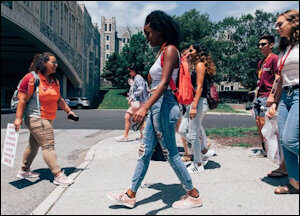 Citing $53 million in additional state support for higher education this year, the boards of Virginia’s public colleges and universities have decided to keep tuition flat for in-state undergraduate students in the upcoming academic year — the first such freeze in nearly two decades, reports the Washington Post.
Citing $53 million in additional state support for higher education this year, the boards of Virginia’s public colleges and universities have decided to keep tuition flat for in-state undergraduate students in the upcoming academic year — the first such freeze in nearly two decades, reports the Washington Post.
James Toscano, president of Partners for College Affordability and Public Trust, paints the freeze as a “significant victory for students and families in Virginia.” As state revenue flows have recovered in states across the country, legislatures are once again investing in higher education. Meanwhile, public institutions recognize that consumers “have reached a pain point that is greater than they can bear.”
Any moderation in higher-ed tuition increases is welcome, for whatever reason and from whatever source. But I am less sanguine than Toscano. I feel certain for two reasons that the cost of attendance will shortly resume its rise. First, the General Assembly is unlikely to sustain $50+ million increases in state support year after year. Between competing demands from other core state responsibilities and the inevitability of an economic downturn at some point in the not-so-distant future, the legislature will be hard-pressed to match this year’s generosity. Second, there is no sign that Virginia’s public institutions have done anything to quell the underlying inflationary forces driving up costs.
I interpret the decisions of Virginia’s governing boards as political, designed to reward the General Assembly for ponying up the extra funds this year and also to undercut those who would cap tuition increases or otherwise hamper the institutions’ autonomy.
The new-found moderation among all public institutions, which was surely a coordinated action, also occurs against a backdrop of declining college enrollments nationally. Nationally, overall enrollment at colleges and universities fell 1.7% this year, or by 300,000 students. Price competition between colleges and universities is heating up.
Community colleges, for-profit colleges and small private colleges have lost the most students, while elite institutions continue to maintain strong enrollments. State subsidies give public colleges and universities an enormous advantage in pricing their tuition and offering financial assistance.
As the Wall Street Journal noted yesterday, Virginia Tech was caught off-guard when far more students enrolled this fall than expected. The universities now is offering financial incentives — funding for community college, gap years, internships, and summer sessions — to some 1,500 freshmen to delay their enrollment and avoid overcrowding. The move comes after a “historic” yield rate that led to about 8,000 students accepting offers from the school, far above the target size of between 6,600 and 6,700 students, he said.
But I have seen no evidence that Virginia’s public colleges have done anything to alter their cost structures. Are they shrinking administrative staff? Are they curtailing sabbaticals or asking tenured faculty and star professors to teach more classes? Are they reducing their commitment to college athletics? Are they rolling back ambitious building programs? Are they trimming departments with declining enrollment? Are they systematically exploring ways to harness computer-aided education and distance learning to increase productivity and quality? If so, they’ve been tight-lipped about their accomplishments.
Ultimately, the cost problem in higher education is a productivity problem. Until they solve the productivity problem, tuition freezes will be short-lived.


